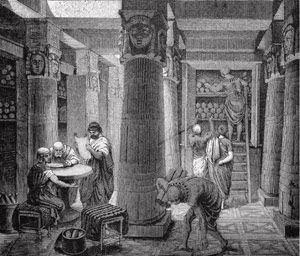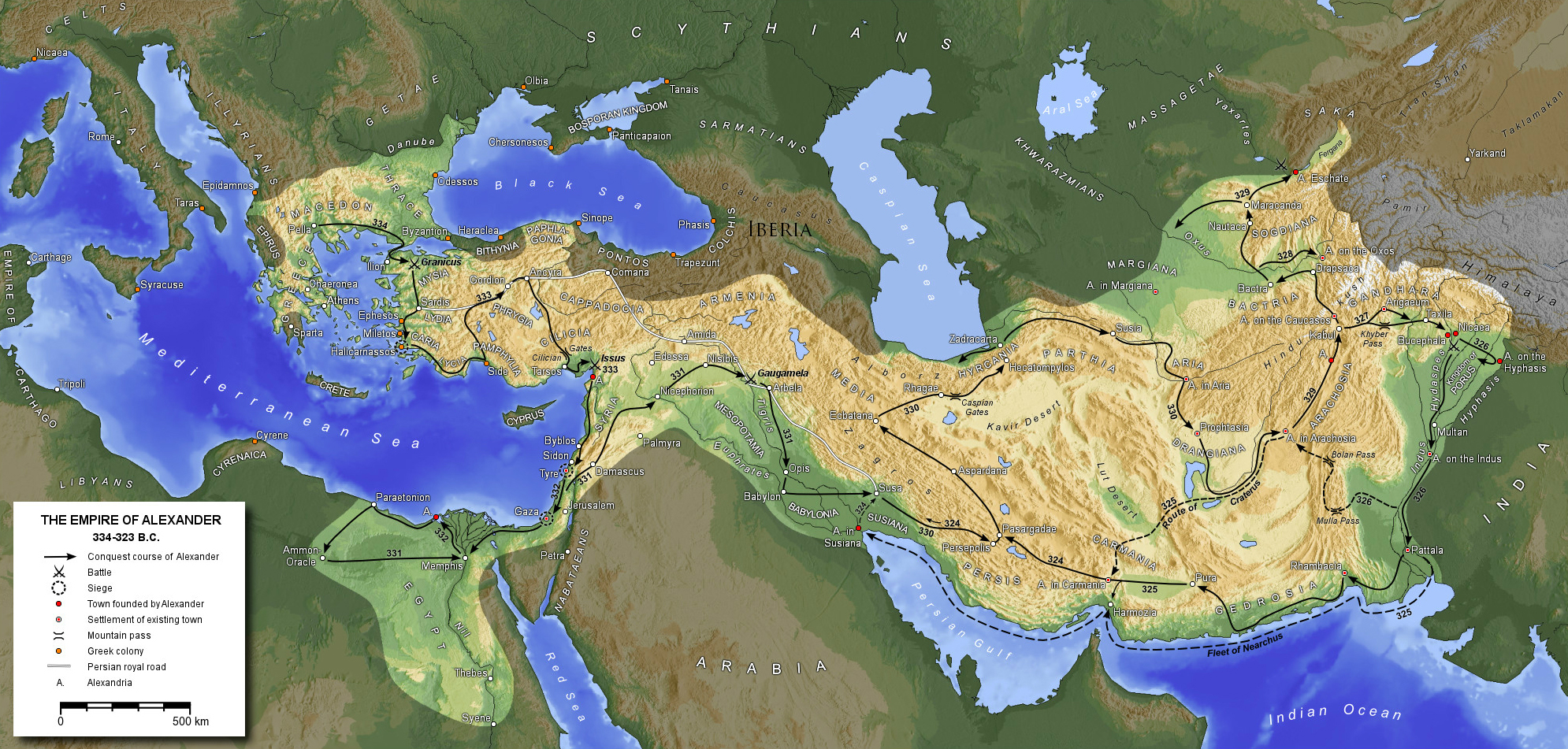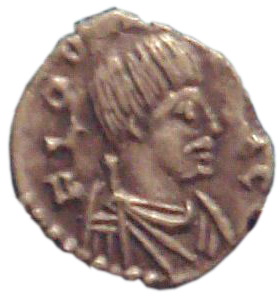
The Journey of Classical Greek Culture to the West
The cultural center of what would become our Western heritage moved from Rome and Constantinople to cities in the Islamic world, the most famous of which were Baghdad and Cordoba. Islamic culture favored learning and tolerance, two major factors that set the stage for the Arab “Golden Age,” which contributed to the birth of the European Renaissance.
“There are more paths from ancient Greece to the modern world than the route leading through the Roman west.” —Carol G. Thomas, ed., Paths from Ancient Greece
Through the deliberate spread of Greek culture, Alexander the Great hoped to forge common links between the diverse regions and peoples of his expanding empire. His conquests included most of the then-known world sprawling over three continents, from Greece down to northern Africa, to Asia Minor and across western Asia to the Indian subcontinent.
Greek influence continued after Alexander’s death in 323 BCE with the Hellenistic kingdoms that followed and flourished until the emergence of the Roman Empire in 31 BCE. During this pre-Roman period, Greek languages, Greek ways of thinking, and the most important Greek writers were introduced to the many non-Greek populations who absorbed them into their own cultures: Egyptian, Iranian, Bactrian, Indian and Phoenician peoples, among others.

The Egyptian port city of Alexandria was envisioned by Alexander in 332 BCE. Sadly, he died before he could begin work on the city that, according to his plan, would hold all the world’s knowledge. In the end it was his friend and trusted general Ptolemy—like Alexander, a former student of Aristotle—who established Alexandria as a metropolis of culture and wealth.

The famous Great Library of Alexandria, built circa 288 BCE by Ptolemy I (Soter), became the world’s center for scholars and scientists. According to Theodore Vrettos in his book Alexandria: City of the Western Mind, “It has never been revealed how the Library functioned, or if its scholars and scientists lived on the premises. … However, one fact is certain: they indeed engaged in scholarly work of immense value, which was intimately connected with the Great Library that stood on their premises. Books and papyrus rolls were collected from every corner of the civilized world, with the aim of gathering together the writings of all men so far as they were worthy of attention. This massive collection of books and scrolls was not limited to Greek and Roman works, Oriental writings were translated into Greek and placed in the Library; as were ancient Egyptian texts, the Hebrew Scriptures, and writings ascribed to the Persian prophet Zoroaster.”
In the third and second centuries BCE, Alexandrian Jews translated the Old Testament into Greek, a version that became known as the Septuagint. At one time there were said to have been around 70,000 papyrus scrolls housed in the Alexandrian library, including works that were confiscated from ships entering the city’s harbor. No one really knows the exact number. The library’s destruction is attributed to two fires that got out of control: one set by Julius Caesar in order to escape the Egyptian fleet in 48 BCE; and the second set by the Emperor Theodosius, who in 391 CE, as part of a campaign to eradicate pagan worship, commanded the destruction by fire of the pagan Temple of Serapis. Most historians agree that the library was finally and completely destroyed by Christian fanatics some three centuries before Egypt was conquered by the armies of Islam.
Greek Legacy and the Roman Empire
When Greece fell to the Romans in 146 BCE, the Roman Empire became the first post-Greek culture to inherit the wisdom of the Greek philosophers. The Romans honored Greece as the source of not only their culture, but also their religion and civilization. In west and central Mediterranean countries, the heritage of Greece was incorporated into Roman culture and modified. As an example typical of the ancient world, characteristics of Greek gods were attributed to and absorbed into their Roman equivalents: Apollo was taken into the Roman pantheon with no name change, Jupiter took on traits from Zeus, Neptune took on traits from Poseidon, and so on.
In the fourth and fifth centuries CE, as orthodox Christianity became established, attitudes changed toward the classical Greek thinkers. The primacy of the Christian church meant that education was devoted to the spread of orthodox Christian thinking and biblical studies, leaving no place for critical thinking or discourse. In 398 CE, the Fourth Council of Carthage prohibited the reading of secular works by bishops. Major figures of the time, although conversant with the classics, were persuaded not to endorse them. St. Jerome (340–420 CE) denied their validity “except for pious ends” though St. Augustine (354–430 CE) believed that philosophical reflection complemented theology. The scholar Sheila Dunn notes that to Augustine, “true philosophy was not possible without both faith and reason and, consequently, there was no distinction between philosophy and theology. Augustine believed that all wisdom was Christian wisdom and all of his writings are concerned with defending or explaining Christianity.”

As northern tribes—first the Visigoths and then the Vandals—moved into Roman territory, the Roman Empire weakened. In 476 CE, the western part of the Empire collapsed, overthrown by the Ostrogoth Odoacer and his “barbarian” (a term that originally meant “non-Greek”) armies. By the time Boethius (480–524 CE) was appointed Roman consul, the Italian peninsula was ruled by the Ostrogoths. Like all members of the Roman aristocracy of his day, Boethius was a Christian, yet he is known today as the “last of the Roman philosophers and the first of the scholastic theologians.” He spoke fluent Greek and intended to translate all the works of Aristotle and Plato from the original Greek into Latin. Before his untimely death by execution, Boethius succeeded in translating Aristotle’s logical works. After Boethius’s death, many of his translations disappeared. Only his translations of Aristotle’s Categories and On Interpretation ever got into general circulation before the twelfth century.
The Celtic monasteries of Ireland helped preserve pagan and Christian writings in both Greek and Latin. For at least 50 years, starting in the mid-sixth century CE, Irish monks sent missionaries to Britain, France and Spain to seek out, study and copy manuscripts, whether Christian or pagan. Under the leadership of Charlemagne, Greek classical works were copied and studied by scholars such as the Carolingian masters Alcuin, Clement, and John Scottus Eriugena, the latter considered the most significant Irish intellectual of the early monastic period. But all in all, too much was lost, and what wasn’t lost was largely ignored by minds too focused on Christian teachings, to the detriment of the ancient classics.
By the end of the sixth century, first-hand knowledge of Greek had died out, leaving very few Latin translations of works from ancient Greece. Learning took place in isolated outposts and monastic sanctuaries. The monastic life attracted some of the best minds of the time. Within monastery walls, ancient manuscripts, mostly religious but occasionally secular, were preserved and copied. Unfortunately, as Rubenstein points out in Aristotle’s Children, the wisdom of classical texts was ignored: “For the next five centuries, they are copied and recopied by monks who hardly know what they are preserving, or why.”
The Eastern Roman Empire and Byzantium
In 330 CE Emperor Constantine I moved the Roman capital to Byzantium, which he renamed Constantinople (“Constantine’s city”). The eastern half of the Roman Empire was geographically more secure than the western half. Emperors in the eastern half exerted control over a well-administered, politically stable region that was far more affluent than other states of the early medieval period.
There, Hellenism survived to become the foundation of the predominantly Greek-speaking Byzantine Empire. Throughout Byzantium, monuments and texts of classical Greece were preserved, copied, and stored in monastic and private libraries. But after centuries of centralized imperial rule, Byzantine thinkers tended to follow imperial pronouncements, which emphasized orthodox Christianity above all else. Reading philosophical treatises was permitted, but their content and the act of reading them came under criticism. Eventually the “pagan” texts of Plato, Aristotle and others were permitted, provided they could be interpreted as supporting the Christian faith.
Plato’s original Academy had been destroyed in 86 BCE by the Roman dictator Sulla. Centuries later in 410 CE, a Neoplatonic Academy was established that served as a center for Neoplatonism and mysticism. Historians such as Norman F. Cantor note that it was shut down in 529 CE by the Emperor Justinian I, “effectively shutting off the intellectual pursuits of the non-Christian professors located there and forcing the leading members of the Academy to relocate. The Byzantines had come to regard philosophy as an alien science: not as a part of the Greek heritage that served the true, Christian wisdom but as a discipline exterior and even irrelevant to it. . . . efforts to combine philosophy and theology were no longer welcome in Byzantium.”

From the fifth century to the eleventh century CE, communication between East and West was disruptive and disrupted by the adversarial nature of the relationship between the Latin and Greek churches and their growing estrangement: “The theological genius of the East was different from that of the West. The Eastern theology had its roots in Greek philosophy, whereas a great deal of Western theology was based on Roman law. This gave rise to misunderstandings that gradually led to two widely separate ways of regarding and defining one important doctrine—the procession of the Holy Spirit from the Father or from the Father and the Son. The Roman churches, without consulting the East, added ‘and from the Son’ (Latin: Filioque) to the Nicene Creed. Also, the Eastern churches resented the Roman enforcement of clerical celibacy, the limitation of the right of confirmation to the bishop, and the use of unleavened bread in the Eucharist.” (Britannica.com). In 1054 CE, the Church of Rome finally separated from the Greek Orthodox Church in what became known as the “East-West Schism.”
As already mentioned, works from ancient Greece were rare in the West and their use so restricted in the East that they have been described by scholars as being little more than museum pieces. Given this and the lack of communication between the two regions, it is certain, as Arthur Herman says in The Cave and the Light, that “without Arab help, western Europe would never have recovered its knowledge of Greek science and mathematics – still the foundations of modern science today – or understood how to interpret it.”
In the series: The Journey of Classical Greek Culture to the West
Further Reading »
External Stories and Videos


Watch: Science & Islam
BBC full series with Jim Al-Khalili
The history of Islamic science and it’s subsequent spread through Europe.
